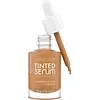What's inside
What's inside
 Key Ingredients
Key Ingredients

 Benefits
Benefits

 Concerns
Concerns

 Ingredients Side-by-side
Ingredients Side-by-side

Water
Skin ConditioningC13-15 Alkane
SolventDicaprylyl Carbonate
EmollientDimethicone
EmollientLauryl PEG-9 Polydimethylsiloxyethyl Dimethicone
Skin ConditioningSilica Dimethyl Silylate
EmollientMethylpropanediol
SolventPentylene Glycol
Skin ConditioningSodium Chloride
MaskingDimethicone Crosspolymer
Emulsion StabilisingStearalkonium Hectorite
Gel FormingPhenoxyethanol
PreservativePropanediol
SolventEthylhexylglycerin
Skin ConditioningSynthetic Fluorphlogopite
Triethoxycaprylylsilane
Propylene Glycol
HumectantPropylene Carbonate
SolventParfum
MaskingEvodia Rutaecarpa Fruit Extract
Skin ConditioningBuddleja Officinalis Flower Extract
UV FilterSodium Hyaluronate
HumectantTocopherol
AntioxidantBenzyl Salicylate
PerfumingLinalool
PerfumingHydroxycitronellal
PerfumingCitronellol
PerfumingLimonene
PerfumingAlpha-Isomethyl Ionone
PerfumingTitanium Dioxide
Cosmetic ColorantIron Oxides
Water, C13-15 Alkane, Dicaprylyl Carbonate, Dimethicone, Lauryl PEG-9 Polydimethylsiloxyethyl Dimethicone, Silica Dimethyl Silylate, Methylpropanediol, Pentylene Glycol, Sodium Chloride, Dimethicone Crosspolymer, Stearalkonium Hectorite, Phenoxyethanol, Propanediol, Ethylhexylglycerin, Synthetic Fluorphlogopite, Triethoxycaprylylsilane, Propylene Glycol, Propylene Carbonate, Parfum, Evodia Rutaecarpa Fruit Extract, Buddleja Officinalis Flower Extract, Sodium Hyaluronate, Tocopherol, Benzyl Salicylate, Linalool, Hydroxycitronellal, Citronellol, Limonene, Alpha-Isomethyl Ionone, Titanium Dioxide, Iron Oxides
Water
Skin ConditioningIsododecane
EmollientDimethicone
EmollientGlycerin
HumectantC12-15 Alkyl Benzoate
AntimicrobialPEG-10 Dimethicone
Skin ConditioningHydrogenated Polydecene
EmollientDimethicone Crosspolymer
Emulsion StabilisingButylene Glycol
HumectantCetyl PEG/PPG-10/1 Dimethicone
EmulsifyingSilica
AbrasiveTrimethylsiloxysilicate
EmollientTocopheryl Acetate
AntioxidantSodium Hyaluronate
HumectantSodium Chloride
MaskingMagnesium Sulfate
Triethoxycaprylylsilane
Disteardimonium Hectorite
StabilisingMethicone
EmollientPropylene Carbonate
SolventEthylhexylglycerin
Skin ConditioningPhenoxyethanol
PreservativeSodium Benzoate
MaskingSodium Dehydroacetate
PreservativeBenzoic Acid
MaskingDehydroacetic Acid
PreservativeAluminum Hydroxide
EmollientCI 77491
Cosmetic ColorantCI 77492
Cosmetic ColorantCI 77499
Cosmetic ColorantCI 77891
Cosmetic ColorantWater, Isododecane, Dimethicone, Glycerin, C12-15 Alkyl Benzoate, PEG-10 Dimethicone, Hydrogenated Polydecene, Dimethicone Crosspolymer, Butylene Glycol, Cetyl PEG/PPG-10/1 Dimethicone, Silica, Trimethylsiloxysilicate, Tocopheryl Acetate, Sodium Hyaluronate, Sodium Chloride, Magnesium Sulfate, Triethoxycaprylylsilane, Disteardimonium Hectorite, Methicone, Propylene Carbonate, Ethylhexylglycerin, Phenoxyethanol, Sodium Benzoate, Sodium Dehydroacetate, Benzoic Acid, Dehydroacetic Acid, Aluminum Hydroxide, CI 77491, CI 77492, CI 77499, CI 77891
 Reviews
Reviews

Ingredients Explained
These ingredients are found in both products.
Ingredients higher up in an ingredient list are typically present in a larger amount.
Dimethicone is a type of synthetic silicone created from natural materials such as quartz.
What it does:
Dimethicone comes in different viscosities:
Depending on the viscosity, dimethicone has different properties.
Ingredients lists don't always show which type is used, so we recommend reaching out to the brand if you have questions about the viscosity.
This ingredient is unlikely to cause irritation because it does not get absorbed into skin. However, people with silicone allergies should be careful about using this ingredient.
Note: Dimethicone may contribute to pilling. This is because it is not oil or water soluble, so pilling may occur when layered with products. When mixed with heavy oils in a formula, the outcome is also quite greasy.
Learn more about DimethiconeDimethicone Crosspolymer is a silicone created by modifying dimethicone with hydrocarbon side chains. Due to its large size, it does not penetrate skin. It is considered non-occlusive.
Dimethicone Crosspolymer is used to stabilize and thicken products. It also helps give products a silky feel.
Ethylhexylglycerin (we can't pronounce this either) is commonly used as a preservative and skin softener. It is derived from glyceryl.
You might see Ethylhexylglycerin often paired with other preservatives such as phenoxyethanol. Ethylhexylglycerin has been found to increase the effectiveness of these other preservatives.
Phenoxyethanol is a preservative that has germicide, antimicrobial, and aromatic properties. Studies show that phenoxyethanol can prevent microbial growth. By itself, it has a scent that is similar to that of a rose.
It's often used in formulations along with Caprylyl Glycol to preserve the shelf life of products.
This ingredient is a solvent. It helps dissolve active ingredients and alter the texture of products.
Propylene Carbonate is commonly used in makeup and with clay, such as montmorillonite or bentonite.
Studies show this ingredient to be safe for cosmetics. When it is undiluted, it can cause skin irritation. (It is always diluted in skincare and makeup). This ingredient is water-soluble.
Propylene Carbonate is created from propylene glycol and carbonic acid.
Learn more about Propylene CarbonateChances are, you eat sodium chloride every day. Sodium Chloride is also known as table salt.
This ingredient has many purposes in skincare: thickener, emulsifier, and exfoliator.
You'll most likely find this ingredient in cleansers where it is used to create a gel-like texture. As an emulsifier, it also prevents ingredients from separating.
There is much debate on whether this ingredient is comedogenic. The short answer - comedogenic ratings don't tell the whole story. Learn more about comegodenic ratings here.
The concensus about this ingredient causing acne seems to be divided. Research is needed to understand if this ingredient does cause acne.
Scrubs may use salt as the primary exfoliating ingredient.
Learn more about Sodium ChlorideSodium Hyaluronate is hyaluronic acid's salt form. It is commonly derived from the sodium salt of hyaluronic acid.
Like hyaluronic acid, it is great at holding water and acts as a humectant. This makes it a great skin hydrating ingredient.
Sodium Hyaluronate is naturally occurring in our bodies and is mostly found in eye fluid and joints.
These are some other common types of Hyaluronic Acid:
Learn more about Sodium HyaluronateTriethoxycaprylylsilane is a silicone used to bind and stabilize ingredients.
As an emulsifier, it helps prevent ingredients from separating. This can help elongate the shelf life of products.
Triethoxycaprylylsilane is often used to coat mineral sunscreens ingredients to help give a better feel. It also helps reduce oxidative stress in sunscreens.
Learn more about TriethoxycaprylylsilaneWater. It's the most common cosmetic ingredient of all. You'll usually see it at the top of ingredient lists, meaning that it makes up the largest part of the product.
So why is it so popular? Water most often acts as a solvent - this means that it helps dissolve other ingredients into the formulation.
You'll also recognize water as that liquid we all need to stay alive. If you see this, drink a glass of water. Stay hydrated!
Learn more about Water